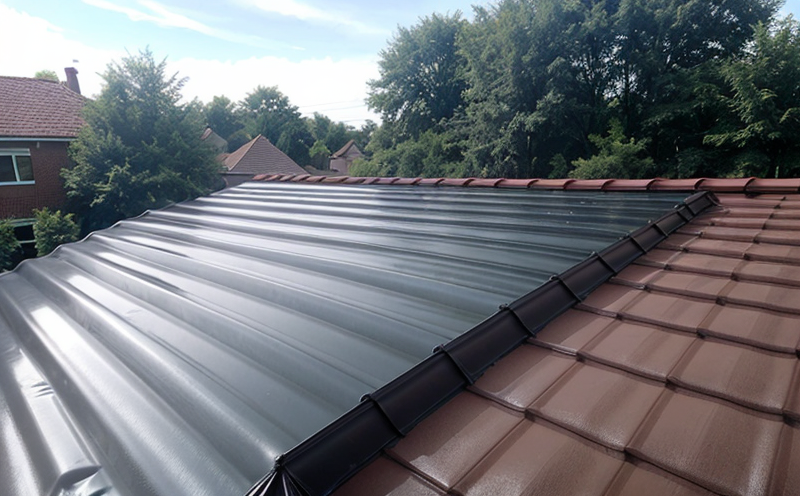EN 13859 Flexible Sheet Roofing Material Testing
The European Standard EN 13859 provides a comprehensive framework for testing flexible sheet roofing materials used in low-slope roofs. This standard is particularly relevant to the building and infrastructure sector, where waterproofing and weather resistance are critical factors in ensuring the longevity of roof systems.
Flexible sheet materials are designed to offer excellent flexibility, durability, and adaptability to temperature changes. They are often used in conjunction with adhesives or mechanical fasteners to form a watertight seal that resists water penetration and wind uplift forces. The EN 13859 standard ensures that these materials meet stringent requirements for performance, durability, and safety.
The testing procedures outlined in this standard encompass a range of physical and mechanical properties that are crucial for the successful application of roofing systems. These include tensile strength, elongation at break, tear resistance, flexibility, water vapor permeability (moisture vapor transmission), and dimensional stability under temperature cycling.
Testing begins with careful specimen preparation, which involves cutting samples according to specified dimensions and tolerances defined in the standard. The specimens are then subjected to a series of tests that simulate real-world conditions, such as exposure to ultraviolet light for accelerated aging, immersion in water at various temperatures, and mechanical loading to assess adhesion.
The results of these tests provide critical data on the performance characteristics of the roofing materials. This information is invaluable for quality managers, compliance officers, R&D engineers, and procurement personnel who need assurance that the materials meet the required standards before application. Proper testing ensures that roofs are not only watertight but also durable and adaptable to environmental conditions.
In summary, EN 13859 provides a robust methodology for assessing flexible sheet roofing materials, ensuring that they can perform reliably in challenging outdoor environments. This standard is essential for maintaining high-quality construction practices and compliance with international standards.
Benefits
The benefits of adhering to the EN 13859 standard are numerous and directly impact various stakeholders within the building and infrastructure sector:
- Quality Assurance: Ensures that roofing materials meet stringent performance criteria, enhancing overall quality.
- Cost Efficiency: By identifying issues early in the testing process, unnecessary rework or replacements are minimized, leading to cost savings.
- Safety: Waterproofing and weather resistance contribute significantly to occupant safety by preventing water ingress into buildings.
- Environmental Sustainability: The durability and performance of roofing materials can extend the lifespan of structures, reducing waste and resource consumption.
- Compliance: Adherence to international standards ensures compliance with regulatory requirements, facilitating smoother project approvals.
- Customer Satisfaction: Reliable, high-quality roofing solutions contribute to customer satisfaction by delivering on expectations for durability and performance.
- Marketability: Compliance with recognized standards enhances the marketability of products, increasing their appeal to discerning buyers.
Customer Impact and Satisfaction
The impact of EN 13859 on customers is profound. For architects and designers, this standard provides a benchmark for specifying high-performance roofing materials that are suitable for various climatic conditions. For builders and contractors, it ensures that the materials they use meet stringent quality standards, reducing the risk of failures during construction.
For property owners, the benefits extend to longer-lasting roofs, which translate into lower maintenance costs and extended building life. This is particularly important in regions with harsh weather conditions where durability is a critical factor. Additionally, compliance with international standards like EN 13859 enhances the reputation of builders and contractors, leading to repeat business and positive recommendations.
For roofing manufacturers, the standard provides clear guidelines for material development and production, ensuring consistency and reliability across products. This not only improves product quality but also facilitates easier market entry into international markets that recognize and adhere to these standards.
In summary, EN 13859 plays a crucial role in enhancing customer satisfaction by providing roofing materials that meet the highest performance standards, thus contributing to long-term building integrity and durability.
International Acceptance and Recognition
The European Standard EN 13859 is widely recognized and accepted internationally for its comprehensive approach to testing flexible sheet roofing materials. Its acceptance extends beyond the European Union, making it a global standard in the building and infrastructure sector.
This standard is often referenced in international agreements and collaborations involving European and non-European entities. For instance, many countries that have ratified ISO standards also recognize EN 13859 as an equivalent standard for testing roofing materials. This recognition facilitates cross-border trade and collaboration in the construction industry.
The widespread adoption of this standard is evident in its inclusion in various international building codes and guidelines. Many countries incorporate EN 13859 into their national standards, ensuring that roofing materials meet the same high performance criteria globally.
Additionally, adherence to this standard can be a key differentiator for manufacturers looking to expand their market reach beyond Europe. By meeting the requirements of EN 13859, companies demonstrate their commitment to quality and reliability, which is attractive to international buyers.
In conclusion, the international acceptance and recognition of EN 13859 contribute significantly to its influence in the global construction industry, ensuring that roofing materials meet the highest standards regardless of location.





